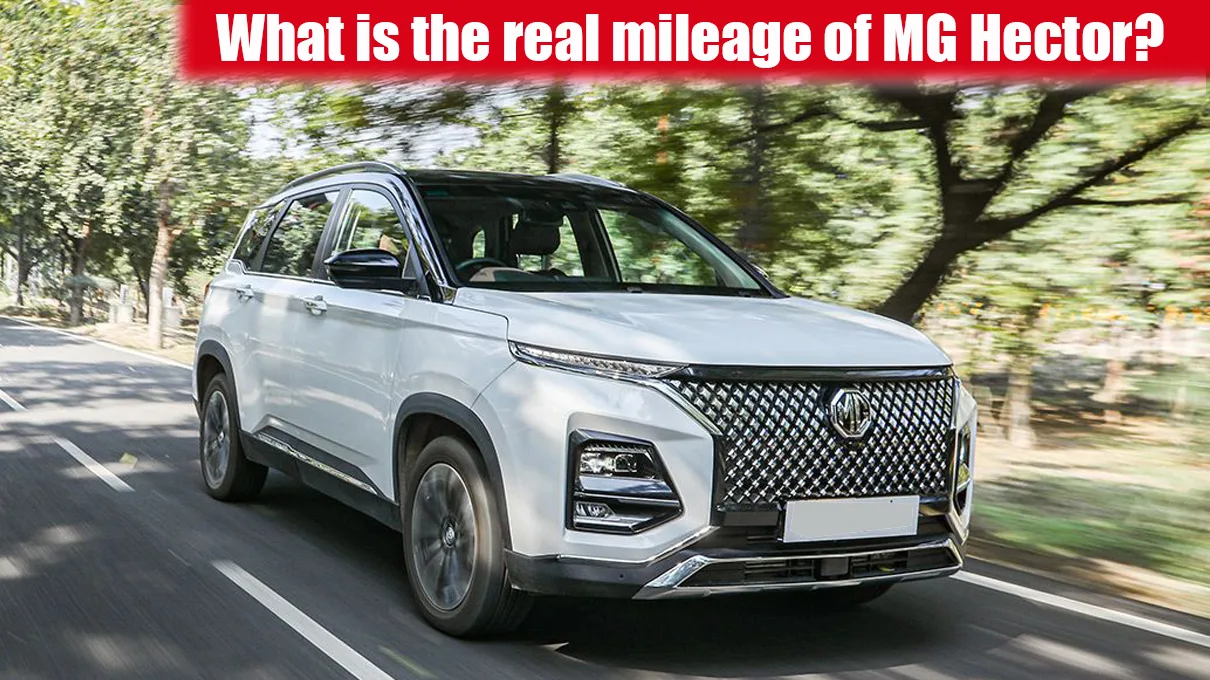Introduction
The MG Hector is a popular mid-size SUV in India, known for its spacious cabin, modern features, and robust engines. The vehicle is available in petrol and diesel engine options, and its mileage varies depending on the engine, transmission, and driving conditions. In this detailed note, we’ll explore the factors that influence MG Hector’s mileage and how it compares to its competitors in the market.
MG Hector mileage
Petrol Engine Mileage:
The MG Hector has two petrol engine options – a 1.5-litre turbocharged engine and a 1.4-litre turbocharged hybrid engine. Let’s examine the mileage numbers for each motor and transmission combination in more detail.
a) 1.5-litre Turbocharged Engine:
The 1.5-litre turbo petrol engine has a 6-speed manual transmission and a 7-speed DCT automatic transmission. The manual variant of this engine delivers a fuel efficiency of 14.16 km, while the automatic variant returns a mileage of 13.96 km. These figures are based on the ARAI-certified fuel efficiency tests and may vary depending on the driving conditions.
b) 1.4-litre Turbocharged Hybrid Engine:
The 1.4-litre turbocharged petrol engine is a hybrid unit that provides a 48V mild-hybrid system. This engine has a 6-speed manual transmission and a 7-speed DCT automatic transmission. The manual variant of this engine delivers a fuel efficiency of 15.81 km, while the automatic variant returns a mileage of 15.43 km.
Diesel Engine Mileage:
A 2.0-litre turbocharged diesel engine paired with a 6-speed manual transmission is the only diesel engine choice for the MG Hector. This engine delivers fuel efficiency of 17.41 km, according to the ARAI-certified fuel efficiency tests.
Variables Influencing the Mileage:
Several variables, such as roadways, traffic, landscape, and repair, can affect MG Hector’s actual mileage.
Let’s take a closer look at each of these factors.
a) Driving Conditions:
The travelling environment affects any vehicle’s mileage. Factors such as traffic, road conditions, and weather can all impact the vehicle’s fuel efficiency. For instance, stop-and-go traffic can reduce the fuel efficiency of a car, while driving on the highway can improve it. Similarly, driving on hilly terrain can decrease fuel efficiency, while driving on flat roads can improve it.
b) Traffic:
Traffic is a significant factor that can affect the fuel efficiency of a vehicle. Stop-and-go traffic can put a strain on the engine, reducing its fuel efficiency. In contrast, driving in light traffic or on open roads can improve fuel efficiency.
c) Terrain:
The terrain over which the car manoeuvres can affect its fuel economy. Driving on hilly or mountainous terrain can put a strain on the engine and reduce its fuel efficiency. In contrast, travelling on flat roads can improve fuel efficiency.
d) Maintenance:
Proper maintenance of the vehicle is crucial to ensure that it delivers optimal fuel efficiency. Regular servicing, oil changes, and air filter replacements can help keep the engine in good condition and improve fuel efficiency.
Comparison with Competitors:
The MG Hector is a popular mid-size SUV in India, competing with other vehicles such as the Hyundai Creta, Kia Seltos, and Tata Harrier. Let’s compare the fuel efficiency of MG Hector with that of its competitors.
a) Hyundai Creta:
The Hyundai Creta is a popular mid-size SUV known for its style, features, and performance. It has three engine options – a 1.5-litre petrol, 1.5-litre diesel, and a 1.4-litre turbocharged petrol. The petrol variant with a manual transmission delivers a fuel efficiency of 16.8 km, while the automatic variant returns a mileage of 16.9 km. The diesel variant provides a fuel efficiency of 21.4 km with a manual transmission and 18.5 km with an automatic transmission. The turbocharged petrol engine delivers fuel efficiency of 16.8 km with a manual transmission and 16.9 km with an automatic transmission.
b) Kia Seltos:
The KIA Seltos is another popular mid-size SUV that competes with the MG Hector. It has three engine options – a 1.5-litre petrol, 1.5-litre diesel, and a 1.4-litre turbocharged petrol. The petrol variant with a manual transmission delivers a fuel efficiency of 16.5 km, while the automatic variant returns a mileage of 16.1 km. The diesel variant provides a fuel efficiency of 21 km with a manual transmission and 18 km with an automatic transmission. The turbocharged petrol engine delivers fuel efficiency of 16.1 km with a manual transmission and 16.2 km with an automatic transmission.
c) Tata Harrier:
Tata Harrier is famous for its features and efficiency. It is available with a single diesel engine option – a 2.0-litre turbocharged unit has a 6-speed manual transmission. This engine delivers a fuel efficiency of 17 km, according to the ARAI-certified fuel efficiency tests.
d) MG Hector:
The MG Hector has two petrol engines and a single diesel engine option. The 1.5-litre turbocharged petrol engine delivers a fuel efficiency of 14.16 km with a manual transmission and 13.96 km with an automatic transmission. The 1.4-litre turbocharged petrol engine with a 48V mild-hybrid system delivers fuel efficiency of 15.81 km with a manual transmission and 15.43 km with an automatic transmission. The 2.0-litre turbocharged diesel engine provides a fuel efficiency of 17.41 km with a manual transmission.
Based on the above figures, it’s clear that the diesel variant of the MG Hector delivers the best fuel efficiency among its competitors. However, the petrol variants of the Hyundai Creta and Kia Seltos offer better fuel efficiency compared to the MG Hector’s petrol engines. Nonetheless, the mild-hybrid system in the MG Hector’s 1.4-litre petrol engine improves fuel efficiency.
Conclusion:
In conclusion, the MG Hector provides a good balance of style, features, and performance. The vehicle has two petrol engine options and a single diesel engine option, and its mileage varies depending on the engine, transmission, and driving conditions.
